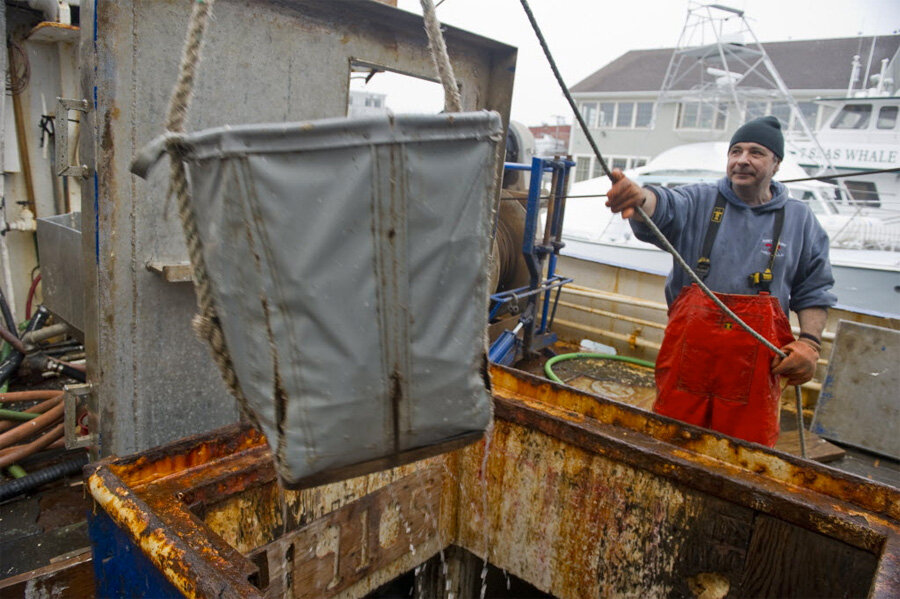Fish in American waters are experiencing population rebounds
Loading...
Fish – at least in the waters off the United States – are making a comeback.
Nearly two dozen species of Pacific groundfish, including snapper, Dover sole, and dogfish, have experienced population rebounds, according to the Monterey Bay Aquarium’s Seafood Watch program. And the 2004 commercial harvest of Atlantic haddock, which had all but disappeared two decades ago, was seven times as large as the 1995 harvest, the smallest harvest on record, reports the National Oceanic and Atmospheric Administration (NOAA) on its FishWatch site.
Haddock stocks have done particularly well in Georges Bank, where the US harvest grew to 9,000 metric tons in 2010. Ten years earlier, US fishermen harvested only a third of that amount, says Chris Kellogg, deputy director of the New England Fishery Management Council.
Alan Risenhoover, director of the Sustainable Fisheries Office at NOAA Fisheries, attributes these rebounds primarily to the US management system and the passing of the Magnuson-Stevens Fishery Conservation and Management Act in 2007. That act mandated the creation of regional fishery management councils and conservation measures such as catch limits on threatened fish stocks.
“If you have a stock where the population is low, you don’t just stop fishing,” Dr. Risenhoover says. “You keep the industry going, lower the limit, and rebuild that stock.”
Ensuring that there are fish left to catch is an imperative in an industry that provides 1.7 million jobs across the country. Hard catch limits have yielded measurable differences, according to Risenhoover, and not just for Dover sole and haddock. While NOAA considered close to 100 fish stocks to be either overfished or subject to overfishing in 2006, that number has been nearly cut in half.
Southern Atlantic black sea bass made it onto this list of recovered stocks just last year. In September 2013, NOAA officials announced that they would double annual catch limits for black sea bass in the Southeast, allowing for a significantly longer fishing season for fishermen. “The more we can rebuild these stocks, the more fish that can be for sale,” says Risenhoover.
Summer flounder, which generates between $20 million and $30 million yearly for commercial fishermen, declined during the 1980s as a result of overfishing. But it has gradually regained its presence in Atlantic waters.
Restoring the population of North Atlantic swordfish, a species that typically migrates to colder waters off Canada during the summer, required an international rebuilding plan that limited catches and protected fish that were not yet fully grown. While battling overfishing of other migratory species such as bluefin tuna has been difficult, the North Atlantic swordfish fishery was declared rebuilt by NOAA in 2009.
But the news isn’t all good. Despite strict regulations, harvest levels for summer flounder sometimes exceeded the catch limits for both commercial and recreational fishermen. And although the Atlantic haddock stock in Georges Bank continues to increase, the stock in the Gulf of Maine has fluctuated, even after fishery managers closed multiple areas to fishing. Mr. Kellogg says that regulations on catching a fish like haddock don’t necessarily make for progress, though, as the cyclical nature of the haddock population likely played an important role in stock rebounds as well.
And just as biological occurrences may help one stock, environmental occurrences may hurt another one. Populations of cod on the coast of New England, once one of the most abundant stocks in the North Atlantic, have plummeted in recent years, and reducing catch limits hasn’t been very effective. Changes in climate conditions, including ocean temperature, may be a reason for population loss, according to Risenhoover, but only further monitoring will tell.
Without a full understanding of the exact causes behind population drops, management councils and fishermen can disagree on what level of monitoring is appropriate. For cod, in particular, fishermen have argued that low catch limits aren’t successful and hurt their industry, but fishery managers aren’t taking that chance.
Globally, the picture is murkier. In 2006, scientists warned of the worldwide collapse of marine ecosystems by midcentury, overfishing being the primary cause.
“The bottom line is that we’re seeing some success in the US,” said Risenhoover. “Success due to the management system and to the willingness of those fishermen to sacrifice a little bit to make sure these fish are around for the long term.”






